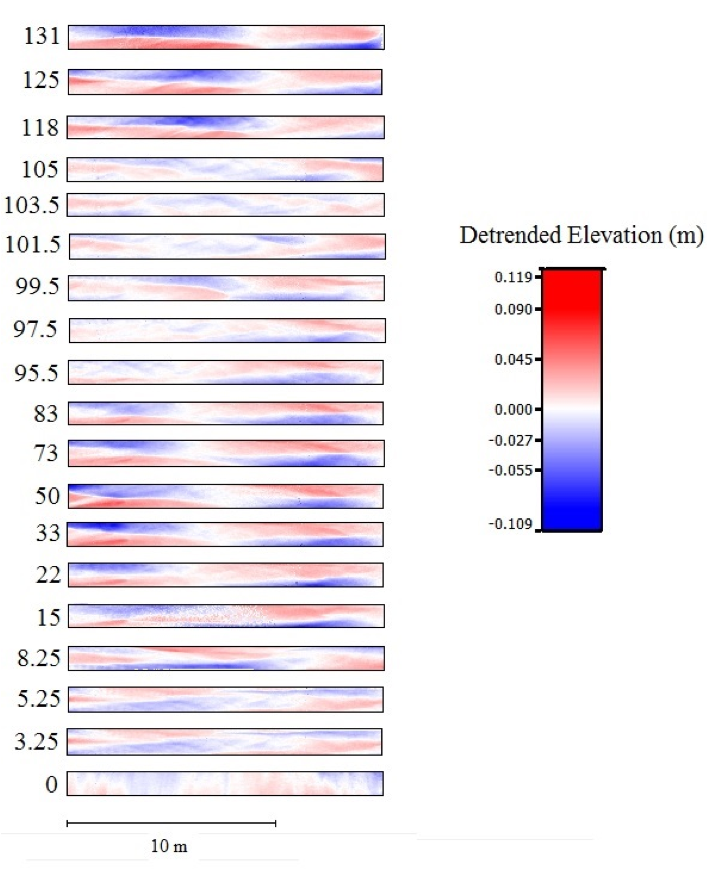Reports: DNI853837-DNI8: Modeling Stratigraphic Feedbacks in Fluvial Morphodynamics
Peter A. Nelson, PhD, Colorado State University
The goal of this project is to use physical experiments and
numerical modeling to explore feedbacks between the creation and consumption of
stratigraphy and the morphodynamics of rivers with
gravel/sand beds. Such feedbacks between the bed surface and its stratigraphy
have largely been ignored in physical experiments, numerical models, and
analytical theory for river morphodynamics, in large
part because we lack coupled observations of bed surface dynamics and
subsurface evolution in gravel-bedded or gravel/sand-bedded rivers and flumes.
This project seeks to fill this gap through two primary activities.
The first involves documenting the coevolution of bed surface morphology and
stratigraphy by conducting experiments in a laboratory flume where a channel
with bar-pool topography is provided a variable sediment supply, resulting in
the creation and consumption of its own laterally- and longitudinally-variable
stratigraphic signature. The second activity involves the development of a morphodynamic model that couples the two-dimensional
(cross-stream and downstream) bed surface evolution with the three-dimensional
(cross-stream, downstream, and vertical) creation and storage of stratigraphy.
During the first year of this project, we have nearly
completed the first activity – the flume experiments. During the second
year of the project, these experiments will be used to guide the development of
the numerical model and to test its ability to make realistic and accurate predictions
of morphodynamic evolution and stratigraphy.
We have conducted flume experiments in the hydraulics
laboratory at Colorado State University's Engineering Research Center (ERC).
The experimental channel is 1.2 m (4 ft) wide, 0.76 m
(2.5 ft) deep, and 18.3 m (60 ft)
long. The overall goals of the experiments were to a) develop alternate bar
morphology by supplying the channel with a constant water discharge and supply
of a gravel/sand sediment mixture, b) to increase the sediment supply and
stimulate the development of stratigraphy, and c) to return to the original
sediment supply rate, causing the channel to degrade through its self-formed
stratigraphy.
During the experiment, we have been periodically collecting
detailed measurements of the bed surface topography using structure-from-motion
techniques. We also have been photographing the bed surface and using image
processing techniques to characterize the bed surface grain size distribution
spatially. At the end of the second, aggradational
phase of the experiment, we collected sediment cores that were used to
characterize the vertical distribution of sediment sizes, along with local bedload transport rates over a bar sequence using a mini Helley Smith bedload transport
sampler.
Figure 1 shows the temporal evolution of sediment feed rates
and bedload transport rates out the end of the flume,
and Figure 2 shows the evolution of the bed surface topography during the
experiment. The flume was fed an equilibrium rate of 100 kg/h for 52 h, at
which point stationary alternate bars had formed in the channel. The feed was
then increased to about 200 kg/h, and again to 300 kg/h, and conditions were at
quasi-equilibrium at the end of each of these higher-supply phases. Immediately
after the increase to a supply of 300 kg/h, a sequence of small bars migrated
over the flume until a new arrangement of steady bars had developed (Figure 2).
The feed was then reduced back to 100 kg/h; the experiments are presently
continuing at this feed rate and will be completed when equilibrium conditions
are once again achieved.
The stratigraphy measurements taken at the end of the
high-supply phase are shown in Figure 3. The channel centerline does not show
much vertical sorting, but locations where bars and pools have formed exhibit
some vertical fining (bars) or coarsening (pools).
As the flume experiments are nearly completed, the major
focus in the second year of this project will be the development of the
stratigraphic morphodynamic model. As part of a
different project, one of my graduate students has made considerable progress
incorporating a framework for storing and tracking riverbed stratigraphy in a
one-dimensional morphodynamic model. A new student
will build upon this, along with my own work, to develop a stratigraphy submodel into the two-dimensional morphodynamic
model FaSTMECH, which is part of the freely-available iRIC interface (www.i-ric.org). The results from the flume
experiments will be used to validate the model predictions, and the model will
subsequently be used to explore surface-stratigraphy interactions for gravel-bed rivers with migrating alternate bars.
As a tenure-track assistant professor, this project has
provided valuable resources allowing me to establish new research in the
hydraulics laboratory, work with graduate and undergraduate students, and
collect valuable experimental data that advance our fundamental knowledge of
earth surface processes and stratigraphic development. The project has provided
the primary financial support for a graduate student, who has taken the lead in
running the experiments and analyzing the data; this has provided him with
valuable technical experience and helped develop his independence and critical
thinking skills. Many undergraduate students have assisted with the
experiments, and this research experience should serve them well as they
consider graduate school or careers in industry.














